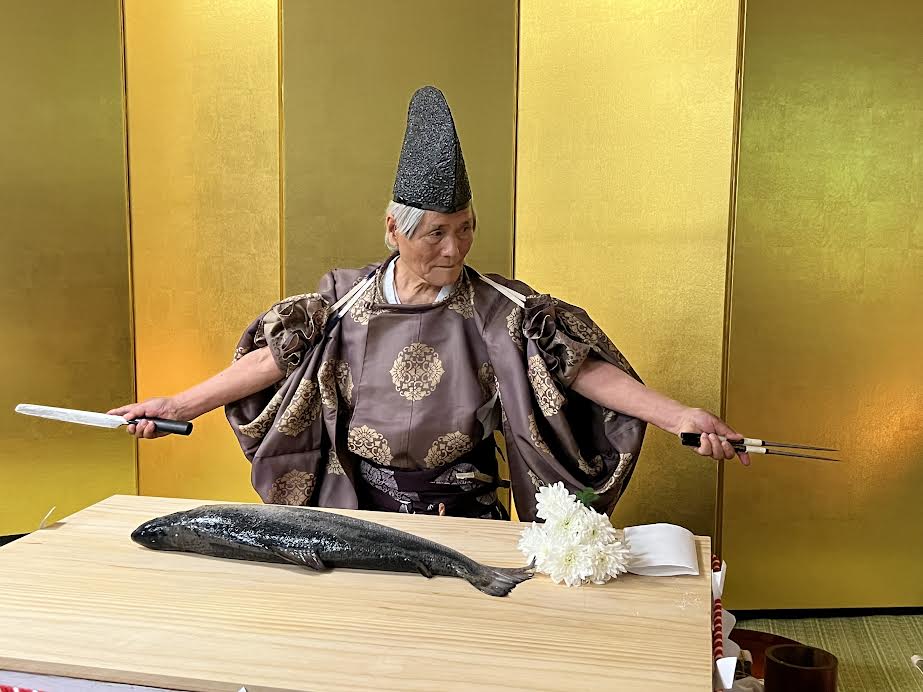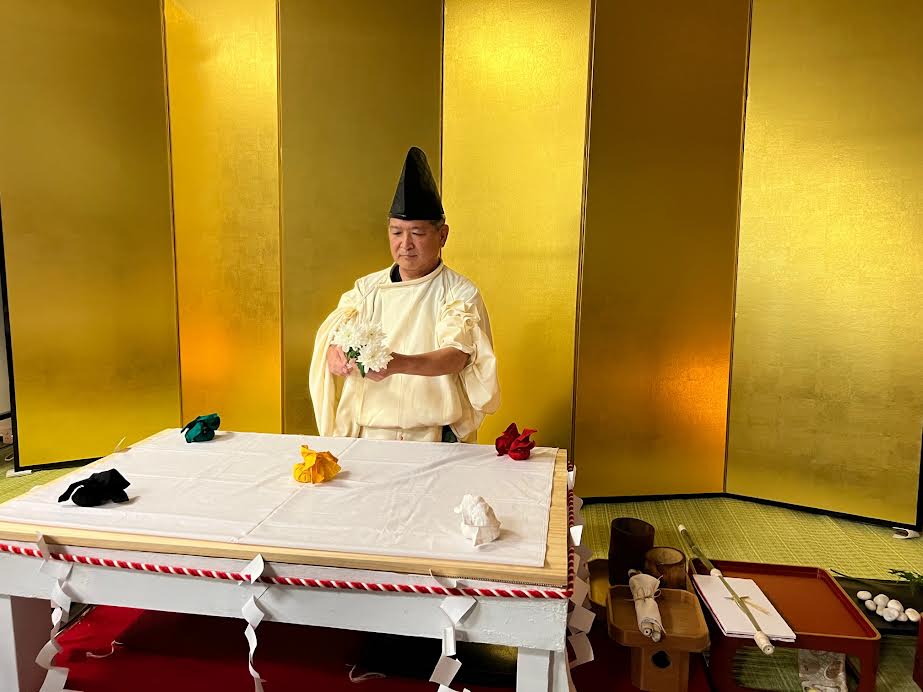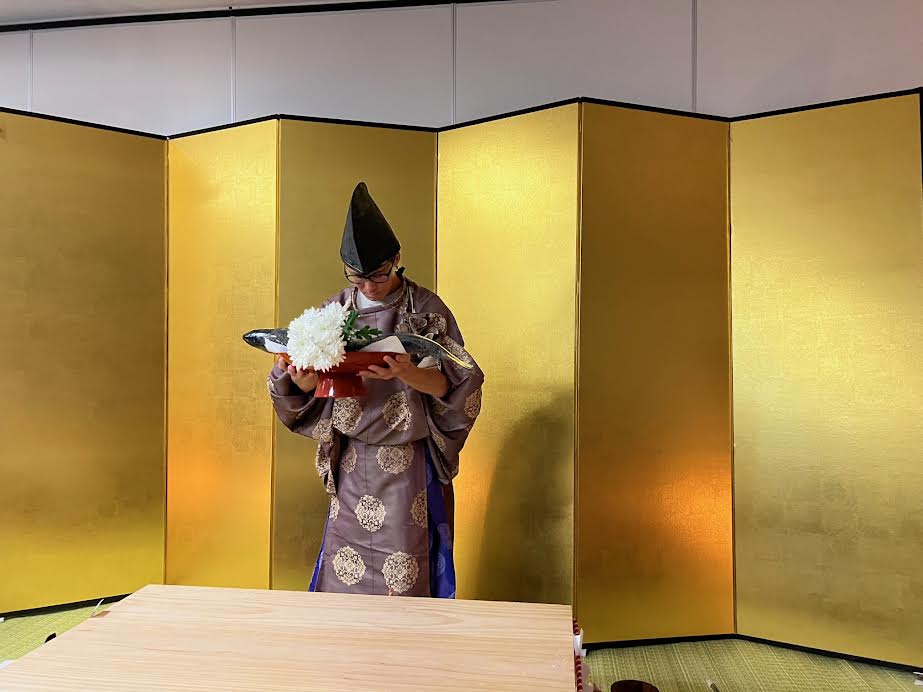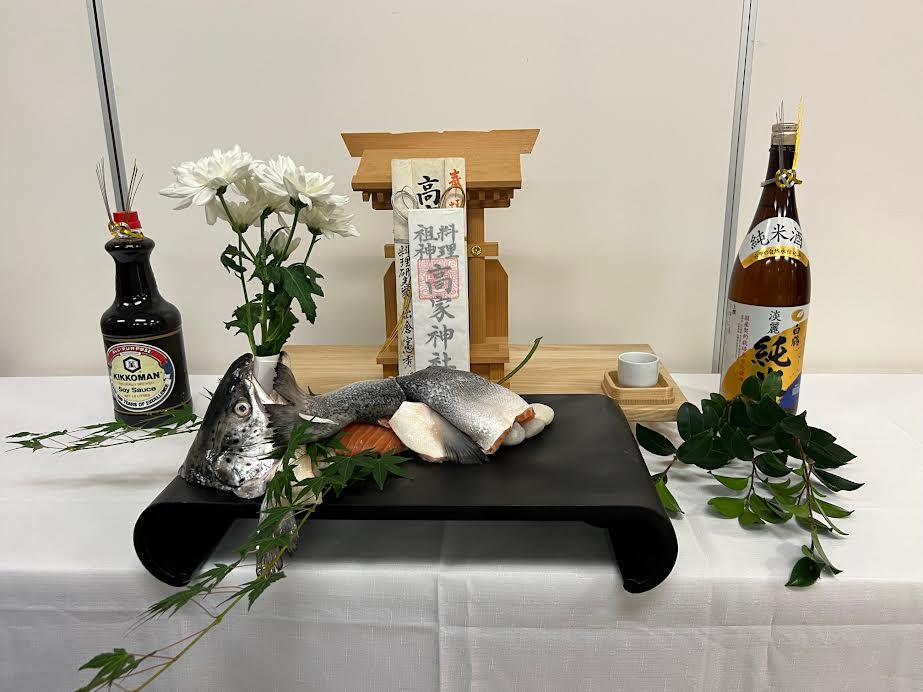Ever heard of Houchoushiki?
Most of us have heard of the Japanese tea ceremony, the cherry blossom ceremony and ikebana, but have you heard of, or seen, the traditional Japanese knife ceremony called Houchoushiki ?
While it represents many essential aspects of Japanese culture, history, and philosophy, few people know about it these days, even in Japan.
I was fortunate to be invited this week to a demonstration by Grand Master Chef Hideo Dekura at the Japan Foundation in Sydney.
Usually performed in Shinto shrines, this sacred ritual is performed by a Japanese culinary expert who carves a whole fish with a long sharp knife using long metal chopsticks without touching the fish with his hands.

Hideo Dekura in traditional hitarare kimono and eboshi hat demonstrating the traditional knife ceremony
Most of those present, including yours truly, had never heard of nor seen this skilful ritual before.
It was a hushed audience which watched Miko, a young Japanese woman, perform a dance to invite the spirit of the Gods into the room. She then gently brushed a camellia across the kamidana (miniature shrine) and clapped her hands, also to invoke the Gods.

Miko, the young Japanese woman, who invited the spirit of the Gods into the gallery
According to Japanese literature, the Houchoushiki is a ceremony with more than 1140 years of history. Three main historical figures contributed to its development: Emperor Keiko whose chef Iwaka Mutsukari no mikoto showed his loyalty and devotion to his master by diving into the ocean to collect bonito and abalone to prepare dishes for the Emperor. The Emperor was so pleased by his efforts and the resulting meal that he rewarded his attendant by appointing him Chef to the Emperor.
The third was Shijyo Chunagon Fujiwara, chef to the Emperor Koukou several hundred years lager. A haiku poem written by Emperor Keiko reflects this feeling:
Kamiga tame
Haru no nomi ide wakanatsumu
Waga koromotemi yuki wa furisutsu
For you
In early spring,
I go out into the fields to collect new buds
Snow keeps falling on my sleeve

Hideo Dekura with long sharp knife and metal tongs preparing to cut the salmon
As Hideo explained: “Can you imagine a time when food was scarce over winter and going out into the snow at the first sign of spring to pick the young leaves full of vitamins to stave off the ills of winter? Imagine even the Emperor himself going out to pick some herbs for someone for whom he cared.
“It is said that this is the devotion of a true chef, and that a truly great chef cooks with the heart and spares no effort to satisfy those for whom he cooks.”
After Miko had performed her dance and summoned the Gods, the first ritual which is the preparation of the wooden chopping board began. Hideo had made a large board measuring 120cm x70cm (4 shaku 3 sun x 2 shaku 5 sun). Each of the corners, and the centre, has a meaning.
Shitoku is obligation to the Gods, time heaven, earth and parents.
Chouchou is respect to the Gods.
Ensui is peace and calm so that nothing is disturbed.
Gogyou is the discipline to follow the doctrines of a master chef.
Shiki is the centre of the board, which is the place for the spirit of the Gods

The 5 bags of rice on the board which represent the seasons
The board had been covered with a cloth and five bags of rice placed on it, the blue one for spring, red for summer, white for autumn, black for winter. Yellow (in the middle) represents the extremes of weather: the hottest summer days, the coldest winter days, the most beautiful spring and autumn days.
As a master chef, it is important to feel the nature of the different seasons and express appreciation through the dishes he prepares.

Laying out the salt which is then skilfully wiped over the board
The rice bags are then removed and replaced by salt which is placed on the five points of the board in readiness for the second ritual. This is the purification of the board (known as manaita-kiyome no go) which involves removing the salt with various implements in a very gentle, controlled manner then wiping the board with purified water to purify it.

The third board ceremony
The third board ritual (Tousanbou no gi) involves laying out the knife and white crysanthemum to pay homage to the Emperor, who in past times may have been present at the ceremony.
Following this, in the fourth board ritual (called Manasanbou no go), the chef takes the salmon from the Sanpou stand and places it on the cutting board, making sure not to touch the fish with his hands.
Then the cutting begins.
The room was silent as Hideo began to cut through the gleaming raw salmon with swift, precise movements, moving each part deftly to a place on the board and positioning it artistically.
His attention never wavered.
I was impressed not just by his knife-handling skills but by his precision and focus which were formidable and reminded me of a scene from a Samurai movie.

The precisely cut salmon arranged on a platter and presented to the Gods of Culinary Arts at the kamidana (miniature shrine)
The precisely cut pieces of fish were then arranged on a platter and presented ceremoniously to the Gods of Culinary Arts at the kamidana.
“It is a symbol of gratitude to the gods for the provision of natural ingredients and the skills required to prepare these foods for our tables” explained Hideo.
“The act of thanking the gods is one of fulfilment which enriches the chef and empowers him with the spirit to make a meal which both gods and people can enjoy.”
It was not just a privelege to witness this sacred Jappanese ceremony, it was also very timely: December 4, 2023, is the tenth anniversary of UNESCO’s recognition of Washoku (Japanese cuisine) as part of the World’s Intangible Culinary Heritage.
With a bow to the Gods of Culinary Arts in Japan – and thanks to the Australia-Japan Society NSW.
